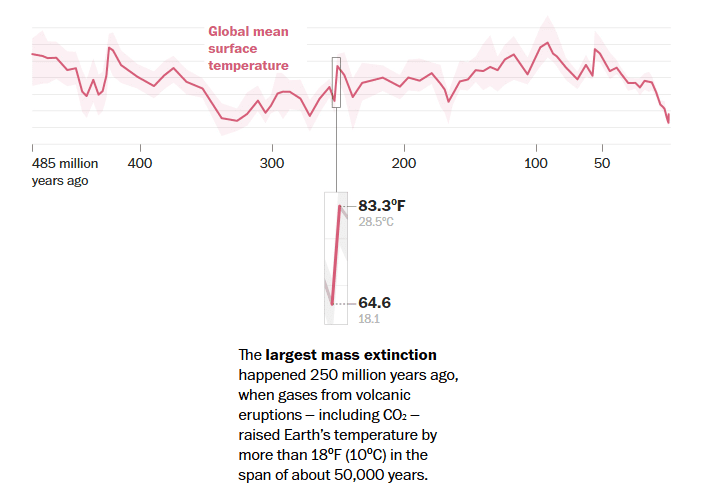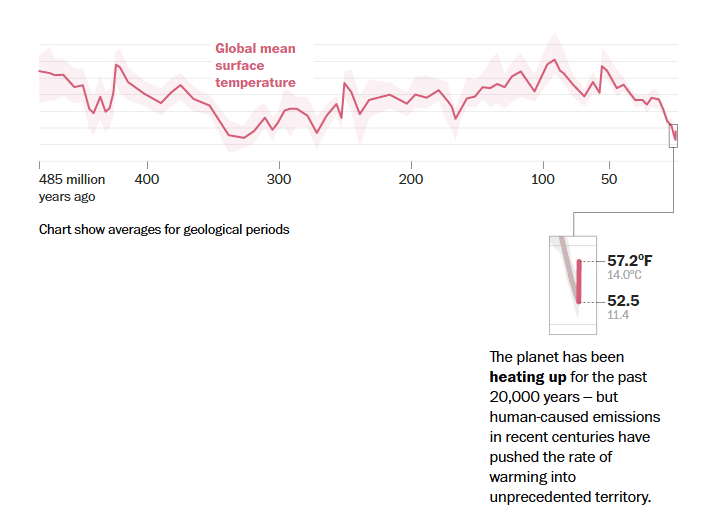An effort to understand Earth’s past climates uncovered a history of wild temperature shifts and offered a warning on the consequences of human-caused warming.

An ambitious effort to understand the Earth’s climate over the past 485 million years has revealed a history of wild shifts and far hotter temperatures than scientists previously realized — offering a reminder of how much change the planet has already endured and a warning about the unprecedented rate of warming caused by humans.
The timeline, published Thursday in the journal Science, is the most rigorous reconstruction of Earth’s past temperatures ever produced, the authors say. Created by combining more than 150,000 pieces of fossil evidence with state-of-the-art climate models, it shows the intimate link between carbon dioxide and global temperatures and reveals that the world was in a much warmer state for most of the history of complex animal life.
At its hottest, the study suggests, the Earth’s average temperature reached 96.8 degrees Fahrenheit (36 degrees Celsius) — far higher than the historic 58.96 F (14.98 C) the planet hit last year.
The revelations about Earth’s scorching past are further reason for concern about modern climate change, said Emily Judd, a researcher at University of Arizona and the Smithsonian specializing in ancient climates and the lead author of the study. The timeline illustrates how swift and dramatic temperature shifts were associated with many of the world’s worst moments — including a mass extinction that wiped out roughly 90 percent of all species and the asteroid strike that killed the dinosaurs.

“We know that these catastrophic events … shift the landscape of what life looks like,” Judd said. “When the environment warms that fast, animals and plants can’t keep pace with it.”
At no point in the nearly half-billion years that Judd and her colleagues analyzed did the Earth change as fast as it is changing now, she added:
“In the same way as a massive asteroid hitting the Earth, what we’re doing now is unprecedented.”
485 million years of temperature turmoil
The timeline encompasses almost all of the Phanerozoic — the geologic eon that began with the emergence of multicellular, non-microscopic organisms and continues today.
It portrays a global climate that was more dynamic and extreme than researchers had imagined, said Jess Tierney, a climate scientist at the University of Arizona and co-author of the study. Compared with graphs based solely on climate models, which tend to depict smaller and slower swings in temperatures, the new timeline is full of sudden spikes and abrupt shifts.
But, in keeping with decades of past research on climate, the chart hews closely to estimates of carbon dioxide in the atmosphere, with temperatures rising in proportion to concentrations of the heat-trapping gas.
“Carbon dioxide is really that master dial,” Tierney said. “That’s an important message … in terms of understanding why emissions from fossil fuels are a problem today.”
At the timeline’s start, some 485 million years ago, Earth was in what is known as a hothouse climate, with no polar ice caps and average temperatures above 86 F (30 C). The oceans teemed with mollusks and arthropods, and the very first plants were just beginning to get a toehold on the land.
Temperatures began to slowly decline over the next 30 million years, as atmospheric carbon dioxide was pulled from the air, before plummeting into what scientists call a coldhouse state around 444 million years ago. Ice sheets spread across the poles and global temperatures dropped more than 18 degrees Fahrenheit (10 degrees Celsius). This rapid cooling is thought to have triggered the first of Earth’s “big five” mass extinctions — some 85 percent of marine species disappeared as sea levels fell and the chemistry of the oceans changed.
An even more dramatic shift occurred at the end of the Permian period, about 251 million years ago. Massive volcanic eruptions unleashed billions of tons of carbon dioxide into the atmosphere, causing the planet’s temperature to shoot up by about 18 F (10 C) in roughly 50,000 years. Acid rain fell across the continents; marine ecosystems collapsed as the oceans became boiling hot and depleted of oxygen.
“We know it to be the worst extinction in the Phanerozoic,” Tierney said. “By analogy, we should be worried about human warming because it’s so fast. We’re changing Earth’s temperature at a rate that exceeds anything we know about.”
The study also makes clear that the conditions humans are accustomed to are quite different from those that have dominated our planet’s history. For most of the Phanerozoic, the research suggests, average temperatures have exceeded 71.6 F (22 C), with little or no ice at the poles. Coldhouse climates — including our current one — prevailed just 13 percent of the time.

This is one of the more sobering revelations of the research, Judd said. Life on Earth has endured climates far hotter than the onepeople are now creating through planet-warming emissions. But humans evolved during the coldest epoch of the Phanerozoic, when global average temperatures were as low as 51.8 F (11 C).
Without rapid action to curbgreenhouse gas emissions, scientists say, global temperatures could reach nearly 62.6 F (17 C) by the end of the century — a level not seen in the timeline since the Miocene epoch, more than 5 million years ago.

“We built our civilization around those geologic landscapes of an icehouse,” Judd said. “So even though climate has been warmer, humans haven’t lived in a warmer climate, and there are a lot of consequences that humans face during this time.”
A paleontological puzzle
The project began nearly a decade ago, when Smithsonian scientists were developing a new fossil hall for the National Museum of Natural History. In a departure from most other paleontology exhibits, which tend to spotlight the strangeness of dinosaurs and other ancient creatures, the new hall sought to draw parallels between Earth’s past and the climate shifts happening today.
But when curators decided to install a graph of Earth’s temperature during the Phanerozoic, they realized that no single timeline existed. Although the scientists could cobble together estimates drawn from disparate data sets and reconstructions of shorter time intervals, the approach left a lot of room for uncertainties and errors.
“That was not very satisfying scientifically,” said Scott Wing, the museum’s curator of fossil plants and one of the authors of the new study. He and his colleagues wanted to create an estimate of past climates in “a statistically rigorous way.”

The first task was to create a database of climate proxies — bits of fossil evidence that hint at how the world once was. For example, the variety of oxygen found in the teeth of extinct, eel-like creatures known as conodonts reflects the water temperature in the oceans where they lived. The chemical composition of fats from ancient algae indicates how they constructed their cell walls to deal with the heat.
Yet the database was restricted to evidence from the oceans, which cover only 70 percent of the planet’s surface. And each proxy could reveal the temperature only at a particular spot at a single point in time. Even with 150,000 data points, Judd said, it was like trying to assemble a jigsaw puzzle with only 1 percent of the pieces.
The researchers could get a better, bigger picture using a climate model — but those simulations might vary a lot based on what assumptions they made about the Earth’s behavior, and the scientists would have no way of knowing which result was the right one. So the team turned to a technique called data assimilation, which combines real-world evidence with climate models to yield more rigorous and accurate results.
“It’s a way of mathematically integrating those handful of puzzle pieces with those possible pictures and finding out, what’s the picture those pieces belong to?” Judd said.
Though data assimilation is widely employed for modern weather forecasts and has been used to create reconstructions of temperature over shorter spans, the timeline published Thursday is the longest and most detailed scientists have ever produced.
It is also more accurate than other estimates, said Benjamin Mills, a paleoclimate researcher at the University of Leeds in England who was not involved in the study, because it uses the data assimilation approach.
“This will contribute to assessing the driving processes behind long-term temperature changes and the natural mechanisms of stabilizing or destabilizing Earth’s climate,” Mills wrote in an analysis that was published alongside the timeline.
‘All the things we don’t know’
The new temperature timeline raises as many questions as it answers, Wing said. Finding global average temperatures of more than 35 degrees Celsius implies that some parts of the planet were even hotter — during the warmest parts of the Cretaceous, for example, average temperatures in the interiors of continents might have reached 122 F (50 C). Even the hardiest modern species would wither in such a sweltering environment.
“It’s an indication of all the things we don’t know about how greenhouse climates work,” Wing said.
Perhaps organisms that evolved during hothouse eras were much better adapted to extreme heat than the plants and animals that live today, he added. Or maybe global temperatures were much more uniform during those periods, with few areas getting much colder or warmer than the average.
Michael Mann, a climate scientist at the University of Pennsylvania who is known for his analyses of past global temperatures, said he was also surprised by the suggestion that the planet got so warm.
The finding supports many scientists’ concern that feedback loops in the Earth system could lead to much higher temperatures than most climate models predict, he wrote in an email. But it’s also possible that the data assimilation assumes too much warming and is missing factors that might forestall a runaway greenhouse effect.
“While I applaud the authors for this ambitious and thoughtful study, I am skeptical about the specific, quantitative conclusions,” Mann said.
Wing acknowledged that there is a lot more work to do. He and his colleagues aim to continue to refine the timeline by adding data from land-based proxies, such as fossil leaves. They also hope it will help researchers trying to model future climate change by allowing them to examine warmer periods from Earth’s past.
And for the billions of people who are now living through the hottest years ever recorded — and facing a hotter future still — Judd said the timeline should serve as a wake-up call. Even under the worst-case scenarios, human-caused warming will not push the Earth beyond the bounds of habitability. But it will create conditions unlike anything seen in the 300,000 years our species has existed — conditions that could wreak havoc through ecosystems and communities.
“As long as one or two organisms survive, there will always be life. I’m not concerned about that,” Judd said. “My concern is what human life looks like. What it means to survive.”





